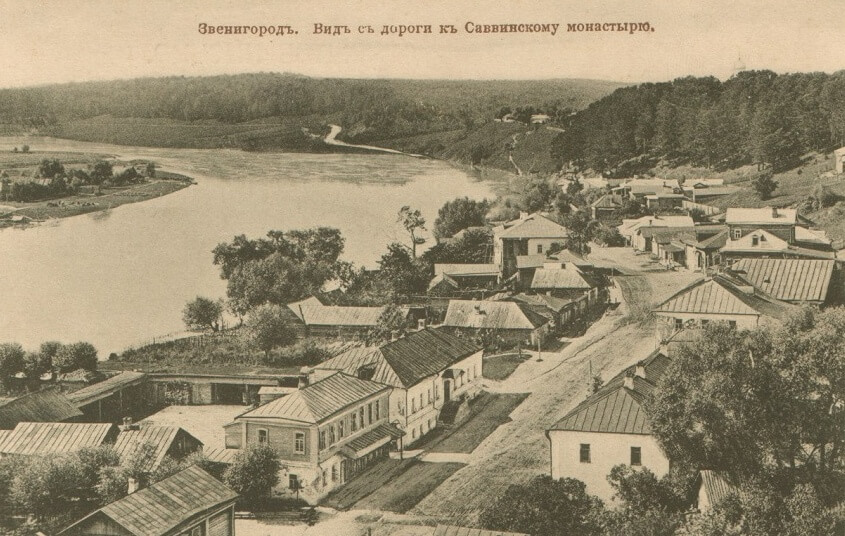History of Zvenigorod
14th Century
Zvenigorod Principality
Although based on archaeological evidence Zvenigorod has existed since the 12th Century, it was first mentioned in 1339 when Grand Prince Ivan Kalita granted the city to his son Ivan Ivanovich. Ivan Ivanovich however remained in Moscow and in 1353 became Grand Prince Ivan II of Moscow and Vladimir upon the death of his elder brother, reunifying Zvenigorod into the Moscow Principality. Ivan II named his infant son, also Ivan, Prince of Zvenigorod in 1356. As before this second Prince Ivan of Zvenigorod remained in Moscow. He died in 1364 of the plague and Zvenigorod was once again returned to Moscow. In 1382 Zvenigorod was attacked by Khan Tokhtamysh of the Golden Horde during his devastating raid of Russian lands. Dmitry Donskoy's son Yury became the third Prince of Zvenigorod in 1389. Unlike the previous princes, Yury Dmitrievich decided to set up residence in Zvenigorod and established the Zvenigorod Gorodok, complete with earthen mound defences. The Dormition Cathedral was constructed within the Gorodok between 1396 and 1399 on the orders of Yury Dmitrievich.
15th Century
Savvino-Storozhevsky Monastery
In 1398 a monk from the Troitse-Sergieva Lavra named Savva, at the invitation and with the support of Prince Yury Dmitrievich, came to Zvenigorod to establish what would become known as the Savvino-Storozhevsky Monastery. The first construction within the monastery was the Nativity of the Virgin Cathedral which was built between 1405 and 1407 in white stone using the funds of Prince Yury Dmitrievich. Savva died in 1407 and was later canonised by the Russian Orthodox Church as St Sabbas (Savva) in 1547.
Zvenigorod Appendage
After the death of Prince Yury of Zvenigorod in 1434, Zvenigorod passed to his son Prince Vasily Yurievich Kosoy who died without issue in 1448. The appendage then passed to Prince Vasily Yaroslavich of Serpukhov and Borovsk. After Prince Vasily's death in 1456, Zvenigorod was given to Prince Andrey Bolshoy of Uglich, then to Prince Yury Ivanovich of Dmitrov.
16th Century
Tatar Appendage
In 1553 Yädegär Möxämmäd, the former khan of Kazan before its conquer by Ivan the Terrible, adopted Orthodoxy and was christened as Simeon Kasaevich. The following year Ivan the Terrible gave him Zvenigorod as an appendage until his death in 1565. In approximately 1569, Zvenigorod's connection with Tatar princes continued when Ivan the Terrible granted to city to Prince Mortazağali, a prince of the Astrakhan Khanate who was christened as Mikhail Kaibulovich. After Mikhail's death in 1575, the appendage was reabsorbed into Russia.
17th Century
Time of Troubles
In April 1605 the First False Dmitry sacked Zvenigorod on his way to Moscow. Villages outside the monastery were burned and the monastery was raided and its money, horses, supplies and bread were taken. In 1607 it was the Second False Dmitry who passed through Zvenigorod on his way to Moscow and brought even more destruction to the city. It was here that he received an ambassador from Tsar Vasily Shuisky.
18th Century
Administrative Reform
In 1708 under Tsar Peter the Great's reforms, Zvenigorod became part of the Moscow Governorate and briefly from 1712 to 1719 it was the centre of the Zvenigorod Province of the Moscow Governorate until it was incorporated into the Moscow Province along with other cities. In 1781 Empress Catherine the Great granted the city a coat of Arms which depicts a bell on a blue background. The symbol of the bell is connected with Zvenigorod as the name of the city is derived from the verb to ring out, as a romantic legend states that bells would ring here to warn Moscow of oncoming danger. In 1784 a regulated town plan was established for the city.
19th Century
Napoleonic War
During Napoleon's invasion of Russia, French troops under the command of Eugène de Beauharnais, step-son of Napoleon, set up camp on the outskirts of Zvenigorod. According to legend an old man appeared to Beauharnais and asked him to order his troops not to harm the monastery. If this wish was fulfilled Beauharnais would return to France alive. The next day Beauharnais visited the monastery and recognised the old man to be St Sabbas. Beauharnais put watch on the monastery to ensure it was not looted by his troops and as promised Beauharnais made it back to France alive.
20th Century
Zvenigorod Rebellion

In November 1917 a group of Red Army soldiers and workers captured Zvenigorod's administrative building and post office without any resistance. However a rebellion started in May 1918 when the Bolsheviks tried to remove the relics of St Sabbas. The Red Army commissar was even killed in the struggle which was only subdued when armed troops were brought in.


 History
History
